|
Bellman
The Story of a Stuart
|
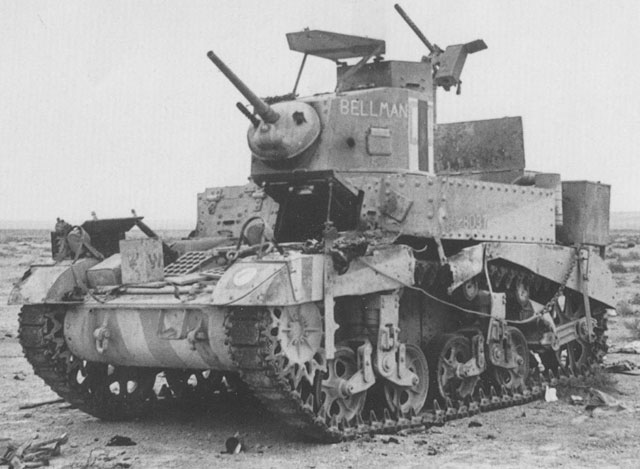
|
|
"Bellman"
- the M3 Stuart in question
(Photo: SANDF Archives) |
by William Marshall

HyperScale is proudly sponsored by Squadron.com
The US General Stuart M2 light
tank, or “Honey” as the British called it. First entering in production in 1941
as the M2A4 model, which soon became the improved M3 light tank. The M3 was
supplied to the British in Egypt in 1941 as the basic light tank.
Designations
British designations for this tank
was:
|
British designation |
US designation |
|
Stuart MK
1 |
M3 |
|
Stuart MK 2 |
M3 Diesel |
|
Stuart MK 3 |
M3A1 |
|
Stuart MK 4 |
M3A1 Diesel |
|
Stuart MK 5 |
M3A3 |
|
Stuart MK 6 |
M5 |
The weaponry of most Stuart’s were
basically the same, a 37mm gun ans Browning co-axial machine gun. The British
removed the sponson-mounted Browning machine gun to create more crew space. The
British named it the "Honey" because of its reliability, speed and ease of
handling.
It served in the British Army in many
roles such as; a cruiser tank; in the reconnaissance role and as an armoured
escort. Later in Italy during 1944/5 some were modified and used as AOP's by
the artillery, having their turrets removed and becoming troop carriers or gun
tractors.
The 7th Armoured Division
The 7th Armoured Division of the
British Army also known as the "Desert Rats”, was the first to enter the desert
war against the Italians in 1941, they soon earned the nickname "desert rats".
During 1941 the 8th
Hussars, 4th and 5th Royal Tank Regiments were brought
together to form the 4th Armoured Brigade. (See Chart 1 for the
organisation)
The "formation sign" of the 7th
Armoured Division was originally a white circle inside of a red square. The
white circle soon acquired a red jerboa (desert rat) as part of their emblem.
Bellman was originally allocated to the 8th Hussars who formed part
of the 4th Armd Brigade.
At the start of Operation
“Crusader” on the 19th of November 1941, Bellman was one of about 51
M3s taking part in the battle.
During the ensuing battle, tanks
were knocked-out, recovered, repaired and supplied to any unit who had the
greatest need. Thus in this confused situation it is virtually impossible to
pinpoint a tanks true unit.
At 15h30 of the second day Bellman
was knocked out by the 5th Panzer Regiment about 5 miles north-east
of Gabr Saleh and was left behind during the retreat.

Chart 1: Basic organisation showing the
main units only
The current colour offering from Academy
seems to be based on colour drawings that were published in Fine Scale Modeler
in November 1997. A number of very good looking models are featured all over the
Internet with the latest offering on HyperScale titled
"Stuart Honey" by Steven Palffy. Colin Shea also features a very interesting
conversion in FSM of July 1999. All offerings seem to have one flaw, to a
greater or lesser degree, the colour schemes depicted.
Bellman was originally supplied to the
British painted in a overall colour of dark green -
possibly middle bronze green or an American equivalent -
or even possibly in British olive drab. I have my doubts
about American olive drab as this was a brownish green colour and should showup
as a lighter colour in black and white. This colour can be seen as the green
rectangle behind the WD number.
The original green colour is also
visible on the attachment points of the sandskirts that seem to have been lost,
quite recently, before the tank was knocked out. The colour is also visible
where shell splinters have knocked of the paint on the left-hand slide.
British vehicles at this stage of the
war were painted in a "Caunter" type of scheme. This comprised of
three basic colours:
-
BSC 61 Light
Stone as the basic colour, (a sand colour).
-
BSC 28
Silver grey, (light green-grey)
-
BSC 34
Slate, (dark green-grey)
Nowhere, have I come across any blue or
blue-grey colour. I think that it would make an interesting subject to try and
determine where this dreadful colour came from, anybody interested?
I see two colours on this tank -
the overall light stone, and possibly slate or silver grey but not both. This
seems to be a sub-Caunter scheme of which there are quite a number of variants
to be seen.
Basic Colour
I believe that Bellman was only painted
in overall BSC 61 Light Stone with a sub-caunter type secondary over spray of
BSC 34 Slate. I do not find any evidence of BSC 28 Silver Grey, even after
placing the photos under extreme contrast and brightness tests (BSC 28 usually
shows up when one does this, see photo 3)
|
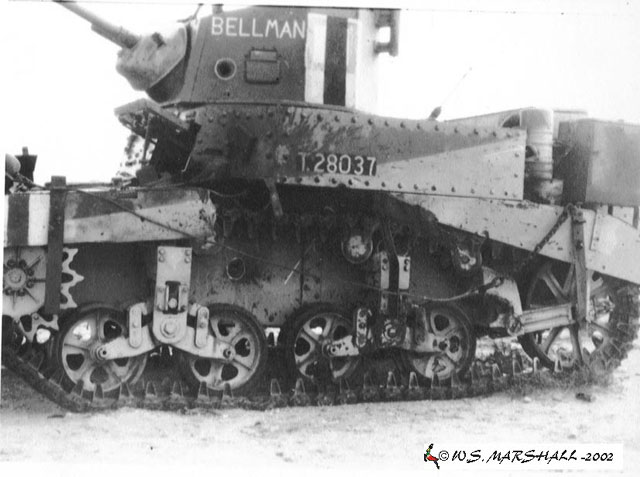
|
|
Picture No. 3: Bellman -
the basic colours (Photo: SANDF Archives) |
|
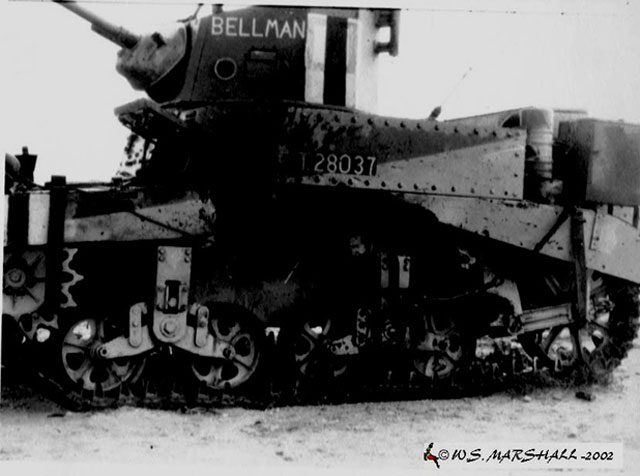
|
|
Picture No. 4: Showing the
contrast and brightness test. |
Markings
Serial number (WD): The serial number on
the side of Bellman clearly shows T. 28037 and not T.28035 as shown in the FSM
drawings and also as depicted in the Academy kit. Sorry guys you will have to
remove the T.28035 serial as this is dreadfully "wrong".
|
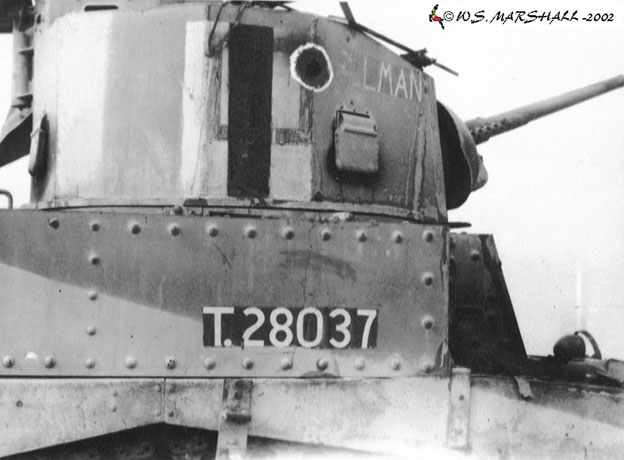
|
|
Picture No. 5: Bellman - The basic colours |
Name
All B Sqd vehicles had names starting
with the letter B as was British tradition. The name "Bellman", in white letters
6" high, on the right-hand side of the turret is in a green rectangle similar to
the background colour of the WD numbers, although it does not seem to be as dark
as the serial numbers background.
|
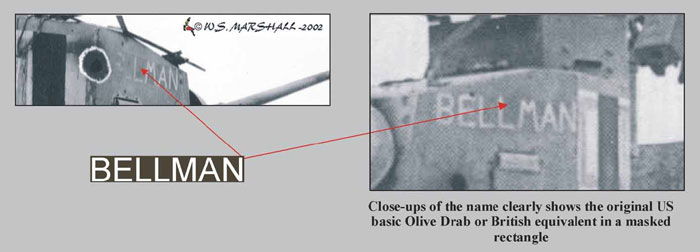 |
|
Picture No. 6: Close-up of the name clearly shows the
original US basic Olive Drab or British equivalent in a masked rectangle |
Tactical Marking
The B sqn tactical square is most
probably in red or orange, it does not quite match the dark red of the
white/red/white bar on the turret. This gives me the impression that it may be
orange or dark yellow, this may not be in line with practice at that stage but
what is? What paint was available in the workshop? I also think that the square
tactical marking was painted first, then all the rest, even an overpainting of
this tac emblem. After the painting was completed the tac emblem was scraped
clean with a sharp object, to reveal the red square, you will see that there are
scraping/scratches on this emblem even through to the original US colour. This
may also explain why the name Bellman and the white/red/white and tactical
square are super-imposed over each other.
|

|
|
Picture No. 7: The close-up reveals that scratch
marks on the tactical marking is clearly evident. |
Armour Recognition Insignia
This is the only part that seems to be
in line with what we know to as correct. The white/red/white bars give a good
solid foundation for judging the colours. I also think that the white/red/white
emblem is painted on the front of the hull, compare the red of this emblem to
those on the side. It would also serve as an addition recognition marking and
would not compromise the tank in any way as this emblem is usually not seen in a
hull-down position. Clearly visible in this view, is the 7th Amd Divisions badge
on the right track sand guard and nothing on the left - it may have been
censored but why only the AoS marking and not both?
|
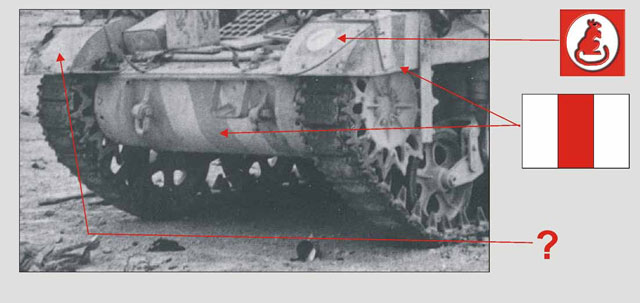
|
|
Picture No. 8: Close-up of the hull showing, in the
author’s opinion, the RAC white/red/white recognition markings, similar to
those on the side, the Jerboa insignia but no Arm of Service No - it may
have been censored? |
I took colour chips supplied by Mike
Starmer in the UK and colour matched them into a palette. These were then
superimposed onto the original drawing in three different shades. The basic
colour, one shade up and one down to allow for weathering, shades, film, etc.
This was then converted to grey scale and a visual comparison made. Colours
that did not match were deleted. The closest possible match was used for the
colour art drawings. I like the results speak for them selves, although it may
not be an acid test that can be proved beyond reasonable doubt in a court of
law. I do think it may be quite accurate and may give a higher degree of
accuracy that the horrible blue colours that one finds on many a model.
Colour Table
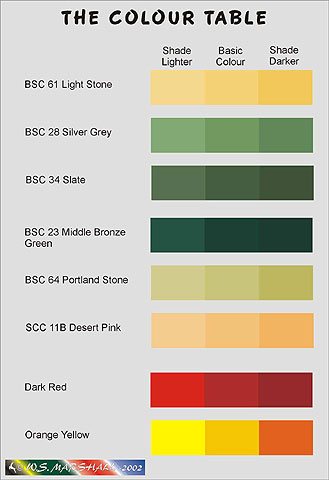
The colour table
showing the basic colour chips.
Test Photo 1
These were then superimposed onto the
original drawing in three different shades. The basic colour, one shade up and
one down to allow for weathering, shades, film, etc.

Test Photo 2
This was then converted to grey scale
and a visual comparison made.

Test Photo 3
Colours that obviously did not match
were deleted. The closest possible match was left on the photo.

Test Photo 4
Possible colours are now superimposed on
the photo to see whether they will match the original.
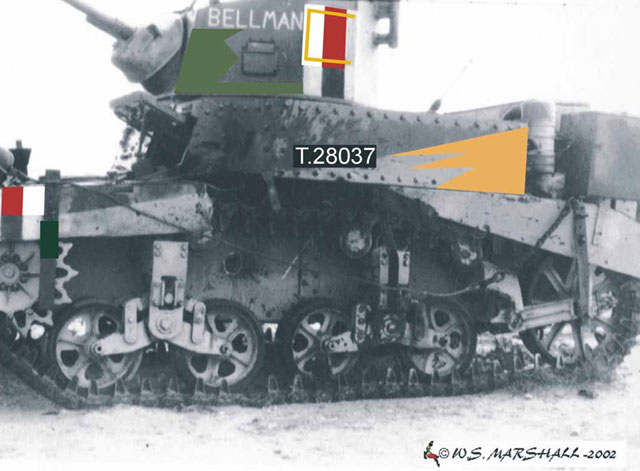
Test Photo 5
When converted to grey-scale one can see
that they blend in quite nicely. Taking into consideration all the arguments
regarding computers and their ability to be totally unreliable regarding
colours, I am quite happy with the results. Surely it seems more accurate and it
looks better than the horrible blue colours as suggested by the model
manufacturers.
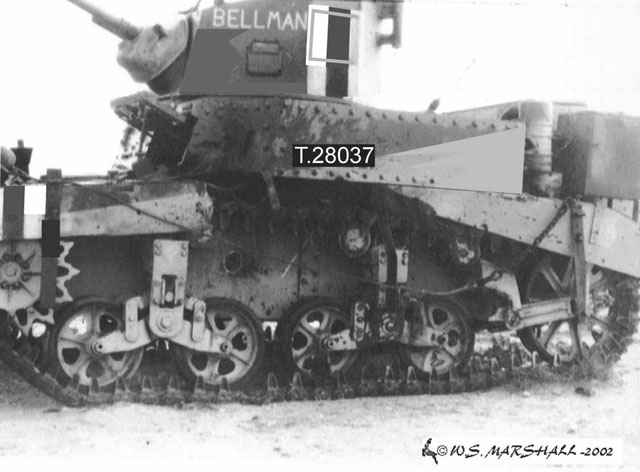
|
Conclusion - The Author's Opinion |
Colours and Markings:
1. The serial or WD number was T.28037.
2. There was no Arm of Service Marking
other than the 7 Armd Div insignia on the track sand skirts.
3. The name Bellman has a US Olive Drab
background.
4. The hull front was painted with the
RAC flash.
5. The tactical red square was painted
first and then scraped clean at a later stage, possibly due to lack of red paint
6. I only see two colours on this tank,
BSC 61 Light Stone and BSC 34 Slate.
7. The sand skirt brackets show the
basic US Olive Drab colour to good effect.
Colour Test:
1. The test has been done taken into
consideration the limitations of the computer generated colours.
2. The colour test is not cast in
concrete and is not the ultimate beyond reasonable doubt test.
3. The test only proves that these
colours could possibly have been used.
4. If any other photo’s appears which
can disclaim any of the results found, please pass them on.
Academy Box Art Picture
Academy box art showing the wrong WD
number, that blue colour and some doubtful arm of service markings.
Fine Scale Modeler:
Issue July 1999, A Honey of a Conversion by Colin M. Shea. Page
38.
Fine Scale Modeler:
Issue November 1997, British Stuart 1 by George Bradford. Page 56.
Military Modelling: Vol 29 No 6
(1999), Desert Honey by Steve Zaloga.
Page 23.
Military Modelling: Dec 1994,
British Military Vehicle Markings of the
Second World War. Page 57.
Armour Camouflage and Markings,
North Africa 1940 -1943 by G. Bradford, Arms &
Armour Press, 1974
British Armoured Units and
Formations (1940 - 1946) by Duncan Crow,
Profile Publications Ltd, 1971.
Text & Images Copyright © 2003 by
William Marshall
Page Created 04 February, 2003
Last Updated
19 April, 2004
Back to Reference Library
|
Home |
What's New |
Features |
Gallery |
Reviews |
Reference |
Forum |
Search